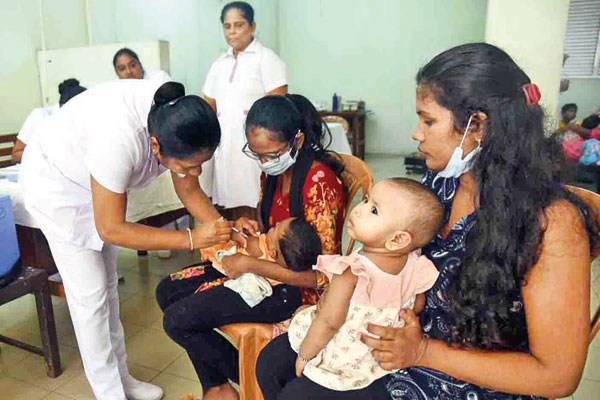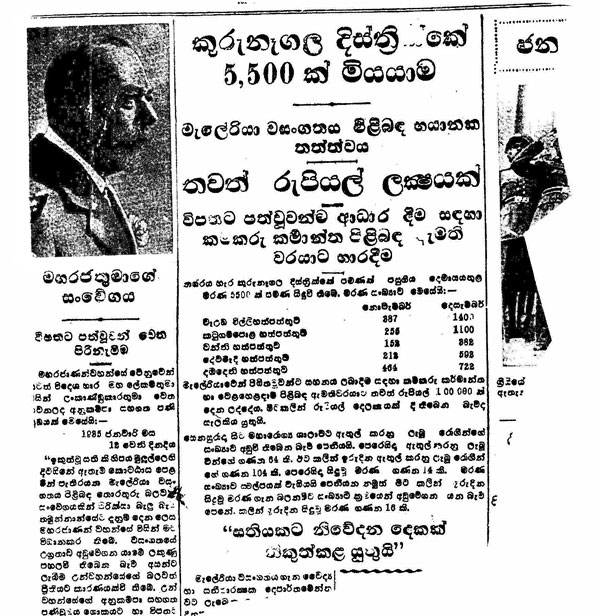Arts
State health sector still robust amidst huge challenges
View(s):By Kumudini Hettiarachchi
The achievements and milestones are numerous even though it is a low-resource setting and in recent times crippled by an economic crunch, serious allegations of severe corruption and brain drain equivalent to a gushing leak.
Vaunted as among the best in the South Asian region, with some indices even on par with the developed world, 76 years after this island-nation gained independence, many are still amazed at how Sri Lanka manages to retain this position in its health sector.
The milestones include – a low Infant Mortality Rate (IMR) & Maternal Mortality Rate (MMR); near-100% immunization coverage; elimination of several major Communicable Diseases (CDs) such as polio, malaria & lymphatic filariasis; great strides in combating Non-Communicable Diseases (NCDs); and a wide range of achievements in surgery including kidney, liver and heart transplants and an array of laparoscopic procedures for different parts of the human body. These are a few of the strides, with many more both in the major specialties and sub-specialties.

Making strides: From preventing Malaria epidemics to successful immunization programmes
The Sunday Times spoke to three professional colleges of the main medical specialties – Medicine, Obstetrics & Gynaecology and Paediatrics – for their views on how the state health sector remains vibrant and robust amidst huge challenges and what the way forward should be.
Medicine
“The people working behind the scenes, both in the preventive and curative sectors, along with backing from the Health Ministry have taken our health to this level,” is the explanation of the President of the Ceylon College of Physicians (CCP), Dr. Upul Dissanayake.
The preventive activities are carried out by the strong network of Medical Officers of Health (MOHs), Public Health Inspectors (PHIs), Public Health Midwives (PHMs) and Public Health Workers who fan out to every nook and cranny of the country.
The curative activities are performed by the widespread lifeline of hospitals – National Hospitals; Teaching Hospitals; Provincial General Hospitals; District General Hospitals; Base Hospitals and Divisional Hospitals, manned by dedicated staff including doctors, nurses, medical technologists, pharmacists and support staff.
Harking back to 1948 when the country gained independence, Dr. Dissanayake says the average life expectancy then was around 52.2 years due to premature deaths but now it is around 80 years.
Chilling are the statistics he gives, when mosquito-borne malaria took its deadly toll – in 1934, our population had been around 5.3 million. About 1.5m had been afflicted by malaria which killed about 84,000.
“Maduruwa marala jayaganna beriwuna (We could not win by killing off the mosquitoes), but through speedy and active responses,” he says, commending the Anti-Malaria Campaign (AMC) which even today responds very fast if clinicians indicate that there is a suspected malarial patient. Now Sri Lanka has no indigenous transmission, only imported cases. The same has been the response with regard to CDs such as diarrhoea, typhoid and Hepatitis A.

Moving to NCDs, Dr. Dissanayake says that with strong treatment, management and rehabilitation programmes, Sri Lanka has been able to reduce the number of deaths and disability due to Cardiovascular Diseases (CVDs) such as heart attacks and strokes.
He recalls how the first Stroke Unit was set up in 1999 at the National Hospital of Sri Lanka (NHSL) by Consultant Neurologist Dr. Jagath Wijesekera and Consultant Rheumatologist Dr. Lalith Wijayaratne followed by others who have taken stroke care to a different level, making many patients get back on their feet to a near-normal life.
Another aspect untouched by others, he brings to the forefront – geriatric medicine which looks at the unique health needs of the elderly, a dire need as Sri Lanka has a rapidly-ageing population. The force behind geriatric medicine was Dr. Dilhar Samaraweera and Dr. Barana Millavithana. Dr. Samaraweera when he returned to Sri Lanka after his post-graduate training had been posted to Medirigiriya, a hospital headed by a District Medical Officer (DMO), but persisted in his passion for elderly care. They have been able to launch an MD programme at the Post-Graduate Institute of Medicine (PGIM) and many are in training even though Dr. Samaraweera himself has migrated.
He also talks of the likes of Consultant Physician Dr. Ananda Wijewickrama and Consultant Paediatrician Dr. LakKumar Fernando who changed the high dengue death rates through a tight management programme, after studying the practices in Thailand. The next goal in dengue management is to bring down the deaths to 0 (zero) and also the morbidity.
Sri Lanka’s successful health story, Dr. Dissanayake attributes to individual change-agents who have gone way beyond the call of duty supported by hard-working nurses in the state hospitals.
To continue these successes, he sends out a passionate plea to stop as quickly as possible the brain drain — in 2022, around 300,000 people from across all sectors had migrated including 14,000 professionals.
Obstetrics & Gynaecology
With regard to women’s health, the President of the Sri Lanka College of Obstetricians & Gynaecologists (SLCOG), Dr. Mangala Dissanayake covers the positive aspects, detailing how 99% of the deliveries of babies take place in hospitals, while antenatal coverage by the PHMs is 99% and post-partum coverage over 75%.
He, however, urges an improvement in quality, as even the low number of maternal deaths which occurred in hospitals are preventable. In 2023, 20% of maternal deaths were due to bleeding, most following Caesarean sections with predictions that the rate of C-sections would reach 50% by 2025.
He hoped that ‘Confidential Enquiries into Maternal Deaths’, a pilot project done in two provinces in July 2022, would be rolled out nationally this year (2024). The other areas of concern were maternal suicides and sexual and reproductive health for internally displaced women and also disabled women.
While urging high clinical standards of care, he points out these are essential to ensure that such care is not under-used, over-used or misused as quality healthcare is the right of all women. Clinical governance, meanwhile, is the “framework through which healthcare organizations are accountable for continuously improving the quality of their services and safeguarding the high quality of care”.
Moving onto another serious concern – the negative impact of the economic crisis – Dr. Dissanayake said that it encompassed food deprivation, increased price of drugs, high transport costs and loss of jobs in the female labour force.
He goes onto explain that ‘out of pocket’ expenditure for pregnant women who accessed only free government health services was 28% for medicine and 14% for tests and investigations. Therefore, there is an urgent need to widen social protection not only for maternal nutrition but also to ensure the continuance of essential healthcare.
Referring to the brain drain and the need to redress the situation speedily, Dr. Dissanayake added that sadly the non-availability of Obstetricians could endanger maternal lives.

Paediatrics
Focusing on the many achievements with regard to child and adolescent health and appreciating the efforts in maintaining them, the President of the Sri Lanka College of Paediatricians (SLCP), Dr. Kosala Karunaratne said that it was important to address the new “pressing problems” brought on by the pandemic, economic crisis and brain drain.
These problems include shortages and misuse of essential drugs and medical supplies, an increase in malnutrition among children, reduced purchasing power for families and the manpower crisis in the health sector.
Following an analysis of the costs of medicine, the SLCP has advocated the categorizing of drugs, reducing wastage and forming drug policies. With regard to the critical shortage of paediatricians, Dr. Karunaratne stressed that “immediate attention and strategic human resource management” were essential while providing an innovative incentive programme and collaborative networking via reach-out programmes.
Meanwhile, he hopes to achieve more milestones such as a further reduction in the Neonatal Mortality Rate (NMR); getting more dedicated Paediatric ICU beds; campaigning against child injuries; promoting the ‘Safe Living and Child Protection’ initiative; dispelling myths with regard to vaccines and vaccine hesitancy; and helping overcome multifaceted challenges faced during adolescence including teenage pregnancies, reproductive health concerns, psychological well-being, cybercrimes and substance abuse.

